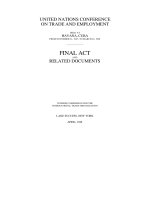Abstract_No_Fools_Choices_Hydrocarbons_Sustainable_Development Final Submission
Bạn đang xem bản rút gọn của tài liệu. Xem và tải ngay bản đầy đủ của tài liệu tại đây (71.16 KB, 1 trang )
NO FOOL’S CHOICE: HOW UNCONVENTIONAL SHALE
DEVELOPMENT FITS INTO A SUSTAINABLE ENERGY FUTURE
FOR EMERGING ECONOMIES
Ning Lin, the University of Texas at Austin, Phone +1 5124221432, E-mail:
Overview
We are in the midst of one significant transformation for the oil and gas sector. On one side, as the development
of new recovery techniques unlocked massive supplies of previously unrecovered hydrocarbon there is yet
significant opportunities for unconventional resource development outside of North America region, especailly
in some developing economies around the globe, to bring meaningful shifts beyond energy. On the other side, the
oil and gas sectors are facing unprecedent challenges and risks to carry out succesful development in unfamiliar
territories and developing countires.
Besides the geological, resource, infrastrucutre and policy issues directly related to the exploration and
production activities in these developing economies, the complexity of the upstream investment compounds
when adding the considerations of meeting uncertainties of decarbonized targets and various expectations from
local governments and major international investors.
This paper explores and constructs scenarios where hydrocarbon development would be integrated as part of a
sustainable energy future for the developing economy, as a possible path to economic shale upstream activities
while factiliate local communities with their long term resource management and energy tranisiont aligned with
country level specfici eocnomic and social prioirites.
Methods
The modeling approach is designed to link behavior, choices, and desired goals to actual outcomes across
multiple discplines, focusing more on the full life cycle developments of the hydrocarbon exploration and
produciton, and explore its impacts and synergies with local resource management and energy planning.
A deep dive into the integrated impacts of upstream investment activities across sectors, combined with local
resource endowment, legacy infrastructures, policy, and economic realities in the form of country-specific study.
This analysis includes three cross-cutting segments:
Regional Air and Water Impacts – a technically rigorous and unbiased report of demand of local
resources in upstream exploration activities and impacts over time, with an array of potential risks and
technology options for local communities and potential investors.
Energy impacts of upstream exploration activities – assess the relative competitiveness of
hydrocarbon types, impacts of cost of energy delivered, impacts of choices of energy technologies. This
section discusses the impacts on regional energy dynamics and choices are given upstream exploration
activities and its potential production going forward.
Economic impact of upstream exploration and development activities – an overall assessment of
ripple effects of upstream development through various sectors in the local economy in a quantitative
way, to capture meaningful and long-run impacts for the industry and manufacturing sectors, labor
market, capital mobility, as well as government spending, etc.
Results
This analysis focuses on putting the moving parts of the puzzle of upstream activities together and discuss the
path forward to optimiza a porfoliot of energy assets and technologies in the region. The analysis provides a
model framework to assess impacts unventional upstream activities and to align interests between industries and
policy makers better, and faciliate better decision making.
Conclusions
In this presentation, one to two case study will be included for demonstration purpose. For the particular case
study, as part of the conclusion, the paper discusses options and strageies for all stakeholders invovled in shale
development process, industry, investors and local policy makers, and address the multitudes of the challenges in
a coherent matter.









